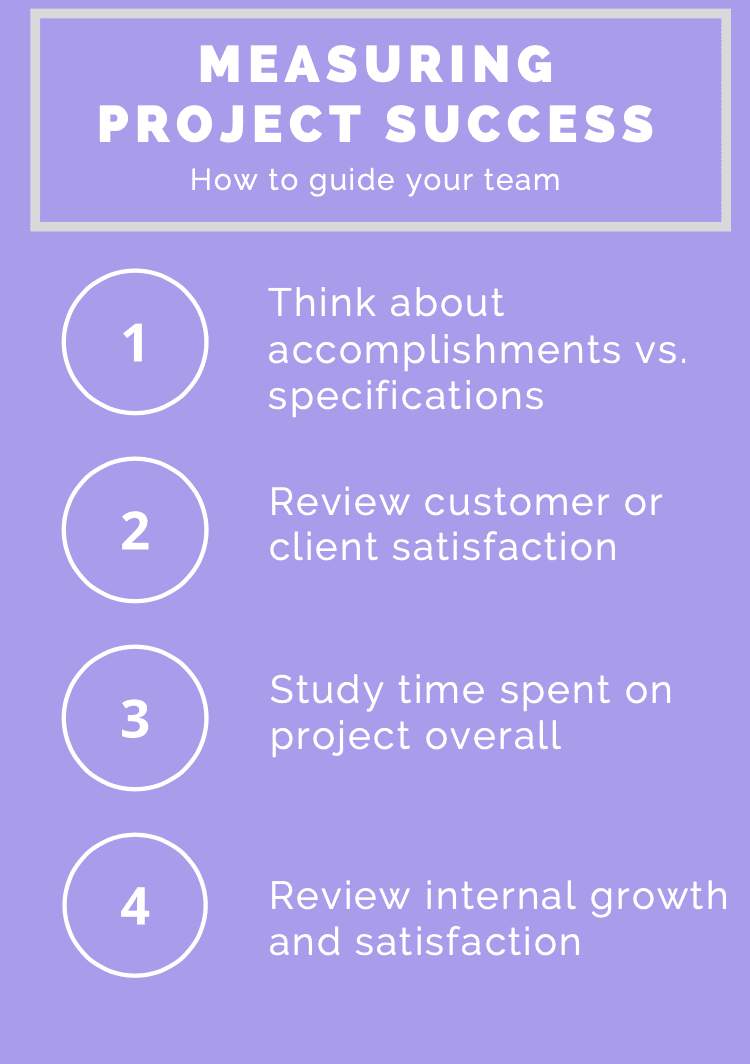When it comes to measuring the success of a project overall, the formula is not always the same every time. Because projects have many moving parts, steps, pieces, and goals, project success can change throughout the project duration. A project you completed for EOY 2022 is probably very different from the project you’re working on in Q3 2023. In this article, we’ll tackle the overall idea of project success and how to measure project success.
One definition that the Project Management Institute provides for project success is that the project has been completed “on time, within budget, and to specification.” This is a very technical definition that might not apply to every project out there, but components of this definition can be useful when understanding how to measure project success.
But before we can measure project success, we need to define it for ourselves. That means you and your team must come together as a group and think about what project success will look like for your internal group. Will it be focused on strict performance metrics and criteria of a campaign? Will it be determined by a client survey or NPS score of the customer? Let’s take a look at the reasons why defining project success is so critical.
The Importance of Defining Project Success
Like I said, whether your definition of “project success” is similar to the technical one matters very little. What’s more important is that you and your team decide what it is going to be internally, and document that somewhere. You could create a rubric for measuring metrics and criteria of success, or you could create a list of things that need to be accomplished for a project to reach “success.”
Once you’ve defined what project success looks like for you and your team, it’ll be much easier to move forward. Here are a few of the primary reasons why:
It will help foster a sense of camaraderie
If your teammates, or others at your organization, all understand what the barometer for success is on a project, they’re going to be more motivated to make it happen. When there isn’t a clear-cut goal for the project, or sub-projects, success becomes difficult to define and team members can get easily discouraged. They’ll also have to work together towards that common goal — this will foster a true team spirit and sense of camaraderie within your organization.
Metrics = gold
Once you’ve defined project success, you need to determine your KPIs and metrics. These are gold for your team. Monitoring your KPIs will allow you to measure exactly how much progress you’ve made, where you need to improve, and how much extra work it will take to get there. If you know your goal is $1M ARR and you’re at $580K with three months to go, you know that you need to kick it into high gear. We work best with strong metrics to support our decisions and project choices.
Continuous improvement
Let’s say you don’t hit that ARR goal that you set out for yourself. That’s OK. You weren’t “successful” traditionally against your project goals this time around, but you can leverage the learnings, pivot, and improve throughout the upcoming year. By measuring project success, you’re also measuring project failure, which is just as important to study. Failure isn’t final.
Project success ladders up
Your definition of project success for your team probably plays into the idea of project success for your managers, the executive team, and even other teams that you collaborate with frequently. Defining project success for your team helps other teams better understand how they’ll work with you, collaborate, and how they’ll end up defining their project success as well.
How To Measure Project Success

Now that we’ve got a basic understanding of the definition of project success and why it’s important to define that term, let’s dig into how we can measure project success overall. As previously mentioned, project success is technically defined as the result of a project being completed “on time, within budget, and to specification.” But how can we actually measure project success? Here are a few ways to do so.
Accomplishments vs. specifications
Immediately after finishing a project, it’s helpful to understand what you accomplished goal-wise versus the specifications of the project you set out to complete. This is, perhaps, the most obvious was to measure project success. Have the main objectives and goals of the project been met? Did you realize that certain specifications were irrelevant along the way? Understanding where your goals track at the end of a project versus the beginning is crucial.
To understand what you’ve accomplished throughout a project, you can always retrace your steps through your emails and pull together a list of all project components. If you’re using a project management tool, you can simply visit the project’s homepage and view all completed tasks. Ideally, each task would be broken up into smaller projects, so you can see where exactly you completed the most work or where you might’ve missed the mark.
Customer or client satisfaction
If you’re working on a project for a specific client, another way to measure project success is by decoding the response you get from your client upon completion. What type of feedback did they have to share? Typically, client satisfaction can be gathered casually on a call, over email, or in a survey form. If you want to accurately measure satisfaction increases from the start to the end of a project, make sure you also survey the client before the project begins.
Customer satisfaction, on the other hand, is a good way to measure project success if this project pertains to customer experience. For example, if we’re building a new feature at Hive, a great barometer for success is how many messages we get about the new feature, or if our NPS (net promoter score), increases on average after its launch. The NPS metric is a key indicator of customer loyalty and satisfaction, measuring the likelihood of customers to recommend your product or service to others. Customers will typically be very honest about their experience, as they view feedback as a way to consistently improve the product. Listen to them!
Time spent on project overall
One of the most valuable resources you have throughout a project’s lifespan is your teammates time. Making sure you can accurately measure how much time you spent on the project, and ideally compare that to time spent on previous similar projects, is a great way to measure project success. Time is money.
There are a few ways you can track time — if you use a project management solution like Hive, you’ve got a great time tracking system, as well as timesheets right in the tool itself. This is great for larger teams that want to track time spent on projects or tasks. While Hive is a robust option, Another alternative would be using a lighter tool like Toggl that focuses primarily on time-tracking.l
Regardless of which tool you end up utilizing, it’s recommended that you break time spent up into smaller chunks so you can best understand where your time is going. For example, how much time did you spend in the project planning phase versus execution? How does this compare to previous projects?
Internal growth and satisfaction with project
If the project you’ve been working on is more of an internal effort or push, a great way to measure project success could be by thinking about internal employee growth and satisfaction. If you’re a manager, ideally you’d like to give your teammates projects that will challenge them and interest them simultaneously.
At the time of a project’s completion, you can survey internal team members about their fulfillment — did they enjoy working on the project? Did they feel like they made progress against larger initiatives that were important to them? Did they acquire any new skills? Keeping employees excited and engaged is great for an organization’s health overall, so this is a great project success measurement metric to consider.
Using Hive to measure project success

Defining realistic success metrics is the best way to truly evaluate the overall performance of your team, using a project management tool can help you with this important task. Hive Goals lets you do just that in an effective, automated and precise way. All you have to do is to set your goals and decide how you’d like them to be measured.
You can track your progress based on:
- Completed actions
- Status of subgoals
- Numerical values
If you want to know the overall time spent on a project, use Hive time tracking. This feature lets you record how long a task takes to complete. Hive lets you choose between automatically or manually tracking your time by action. Enable the timer in your action card to track time for you, or add it at the end of the day, week, or month.
With Hive Goals you can also:
- Create one, ten, twenty, or more goals for your team, so everyone understands what they’re contributing to.
- Centralize and automate your goal tracking and reporting.
- Pull data from other systems into Hive to streamline operations and reporting.
- Share your goal or goals, assign the goal to relevant teammates, track activity, and give yourselves a deadline.
- Understand how your team and organization are pacing towards an individual goal or a set of goals.
- Color-coded designations allow an easy understanding of “on-track” items.
- When it’s time to review progress, accomplishments, and achievements, easily export all relevant information.
There’s much more you can accomplish for your business success using Hive Goals. Want to get started? Start your free trial of Hive Goals today!
Overall, when you measure project success, it isn’t a straightforward process. When thinking about measuring success at the end of a project, you need to consider several factors, primarily the time you’ve invested and if you’ve achieved the key milestones you set out to tackle. But remember, project success isn’t always metrics-driven — it can be more nebulous when it comes to overall satisfaction on the internal or external side.






